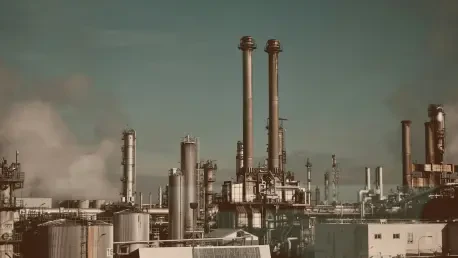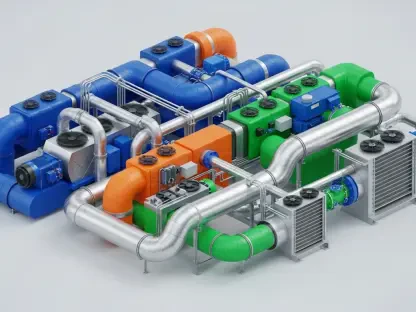In a climate marked by economic shifts and global trade uncertainties, the chemical industry finds itself navigating through uncharted waters. This tumultuous period, particularly affecting key players such as Dow, presents a tapestry of challenges revolving around financial strategies, market dynamics, and a rapidly evolving competitive landscape. As these companies recalibrate their approaches, the industry’s overarching themes focus on maintaining operational stability while preparing for eventual recovery. Dow’s recent adjustments, notably its decision to slash dividends, serve as a significant indicator of the prevalent challenges, signaling a prolonged downturn that’s reshaping industry strategies and expectations.
Dow’s Strategic Adjustments
Cutting Dividends: A Response to Market Conditions
In a bold maneuver reflecting the industry’s persistent challenges, Dow halved its dividend, highlighting the downturn’s enduring nature. Initially, expectations framed the downturn as a transient phase. However, ongoing unfavorable conditions have extended it far beyond prior projections, now entering a third year. This dividend cut points to a broader strategy to prioritize financial viability amidst declining margins and stagnant growth. Following this announcement, investor reactions reflected in a sharp 16% dip in Dow’s midday share value, signaling widespread concerns over the chemical giant’s immediate trajectory and the industry’s capacity to rebound swiftly.
Despite presenting an initial setback, Dow’s leadership maintains an outlook anchored in eventual market stabilization. The company reported a significant net loss of $801 million for the second quarter, shedding light on intensified operational and financial hurdles. However, there is some optimism for a marginal sales recovery in the third quarter. This positive note, albeit slight, emerges amid a decline in comparisons with last year’s figures, illustrating an industry grappling with complex headwinds while cautiously eyeing future opportunities for growth and recovery.
Short-Term and Long-Term Market Outlook
The chemical industry, especially sectors involving polyethylene and derivatives, is caught in a flux driven by a complex web of global trade dynamics and internal challenges. The current climate is characterized by a distinct downturn in demand, exacerbated by tariffs that have reordered customary trade pathways. Notably, these reconfigurations affected Dow’s exports, leading to a marked decline in polyethylene pricing, dropping by 3 cents per pound. Such developments, resulting from protective trade measures, underscore the industry’s vulnerability to geopolitical shifts and highlight the importance of strategic agility in navigating these intricate landscapes.
Looking beyond immediate turbulences, Dow persists in its efforts toward modest quarter-on-quarter sales recovery, buoyed by intended polyethylene price hikes. These adjustments aim to offset unsustainable margins, setting a stage for improved profitability. Furthermore, the introduction of a new polyethylene facility, Poly 7 in Freeport, Texas, is poised to enhance Dow’s earnings. This plant’s production is strategically directed towards high-margin sectors, including specialty packaging and hygiene products, reinforcing a commitment to tapping into market niches less affected by broader downturns.
Industry Challenges and Opportunities
Navigating Oversupply and Trade Barriers
The chemical industry’s current predicament is deeply interwoven with factors like global oversupply and shifting trade routes. The sector faces a substantial oversupply, particularly in polyethylene and polyurethanes, products pivotal to various applications across industries. This surplus, accompanied by a slower-than-anticipated demand recovery, poses significant challenges for companies like Dow. The anticipation that global demand will eventually outpace GDP growth tempers these concerns, suggesting a bright spot on the horizon for strategic investments, especially those aligned with sustainable materials and practices.
Compounding the issue is the pronounced impact of trade tensions, driven by evolving geopolitical dynamics and novel tariff schemes. This has prompted a reconfiguration in global trade routes, impacting chemical derivatives more than basic chemical commodities. These newly aligned trade routes have intensified market rivalry in regions such as Southeast Asia, where demand for upstream chemicals has seen a notable decline. This shift necessitates recalibrating export strategies to maintain competitiveness in these newly contested markets while ensuring alignment with evolving regulatory frameworks.
Strategic Adaptations and Innovations
Incidentally, the ongoing downturn presents an inflection point for the chemical industry, sparking introspection and stimulus for innovation. Dow’s strategic trajectory underscores critical moves towards geographic market diversification and capacity management. These strategies, framed by an overarching ethos of innovation, are poised to equip players with robust tools for counteracting prevailing challenges while fostering resilience. The commitment to sustained adaptation, as evidenced by strategic capacity expansions like Poly 7, positions companies to harness potential future demand, particularly in segments less prone to cyclical fluctuations, such as sustainable plastics and high-end derivatives.
Furthermore, navigating through this period calls for embracing innovation not just in operations but also in exploring sustainable practices. Dow’s dedication to refining product lines signals an emphasis on sustainability, aligning with broader industry trends towards environmentally conscious initiatives. Such forward-thinking approaches highlight the necessity for companies to integrate sustainability as a core component of their operational ethos, which in turn can yield long-term benefits both economically and reputationally in an increasingly eco-conscious global marketplace.
Industry-Wide Implications and Perspectives
Cross-Industry Challenges and Strategic Insights
The challenges faced by Dow and its peers are emblematic of broader struggles within the chemical sector and adjacent industries. For instance, Sherwin-Williams, a recognizable player in the paints and coatings market, has adjusted its financial outlook, acknowledging that the growth resides more in capturing market share than relying on economic expansions. This sentiment resonates with Dow’s adjustments, emphasizing a need for strategic introspection industry-wide, which prioritizes market positioning and internal efficiencies over external market conditions for growth.
Conversely, some companies, like HB Fuller, have successfully raised their projections, demonstrating the efficacy of leveraging internal strategies over relying on global market conditions. This contrast illustrates how adept navigation through turbulent periods sometimes necessitates bold, internally focused adjustments, complete with agility and foresight in response to evolving market conditions. Such insights, drawn from broader industry evaluations, underscore the criticality of strategic acumen in achieving sustained operational stability and capitalizing on potential post-downturn opportunities.
Embracing Resilience and Innovation
Across the sector, resilience through innovation emerges as a pivotal theme. The chemical industry’s ability to weather ongoing challenges, as demonstrated by Dow’s initiatives, will undoubtedly shape its path forward. Operational resilience, typified by internal efficiencies and leveraging innovative capacities, is crucial for not only sustaining operations but also readying for an anticipated recovery. The emphasis on research and development, particularly towards product diversification and enhancement of sustainable solutions, offers pathways for aligning operations with evolving consumer and regulatory expectations.
Moreover, the sector’s embrace of digital transformations represents another avenue for fostering resilience and innovation. Adopting digital tools and processes can enhance supply chain efficiencies, optimize production, and improve stakeholder engagements, providing the tools necessary for accurately navigating uncertainties. Inculcating these technological enhancements positions the industry to adapt effectively, equipping players to meet new demands and reshape competitive advantages in an evolving marketplace.
Strategic Responses and Future Trajectories
Pathways to Recovery and Growth
The chemical industry’s current trajectory underscores a period marked by adaptation, innovation, and strategic realignments. With Dow at the forefront, industry players are increasingly focusing on efficiency, sustainability, and market diversification as they navigate this challenging landscape. Strategic capacity management, exemplified by facilities like Poly 7, coupled with price adjustments in polyethylene, reflects a commitment to achieving short-term stability while preparing for long-term opportunities.
Trade tensions and geopolitical shifts continue to influence market dynamics significantly. Companies like Dow prioritize understanding these changes to implement strategic responses that stabilize finances and align operations for future growth. Flexible pricing strategies, diversification into less affected markets, and sustained commitment to sustainability reflect broader industry strategies focusing on resilience alongside adaptability.
Sustaining Industry Focus
In an era characterized by fluctuating economies and uncertainties in global trade, the chemical industry is grappling with challenging conditions. Major companies like Dow are facing a complex array of hurdles that revolve around financial management, shifting market landscapes, and a swiftly changing competitive environment. As these corporations reassess their strategies, the industry centers on themes of sustaining operational effectiveness while readying for potential recovery. A notable adjustment by Dow, its decision to reduce dividends, highlights the significant challenges present, indicating a prolonged economic decline that is reshaping the strategic outlook and expectations of the industry. The industry must now focus on innovation and resilience to weather these trials. Dow’s moves underscore an effort to secure long-term stability amidst trying times. As they navigate this period, adaptation and foresight are crucial in overcoming obstacles and preparing for eventual recovery in a new business normal.









